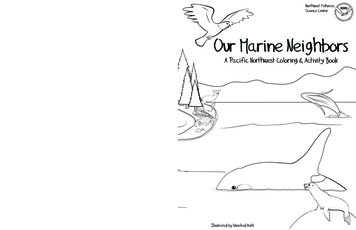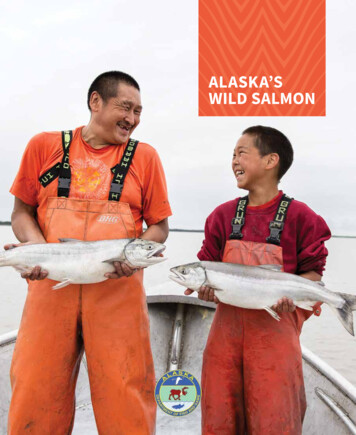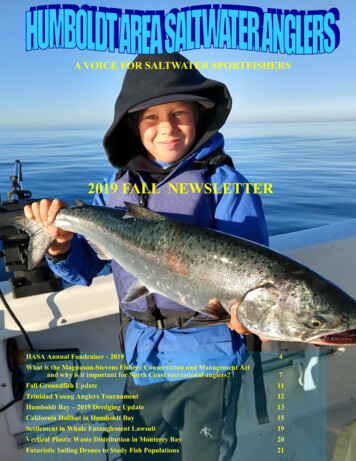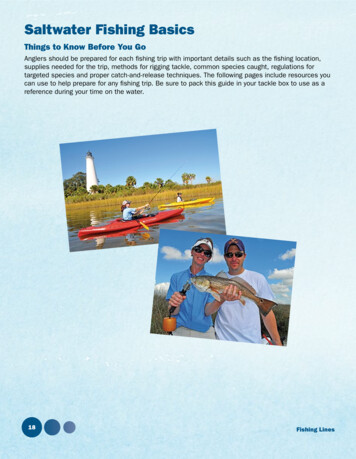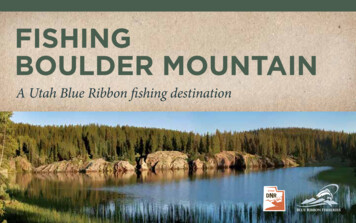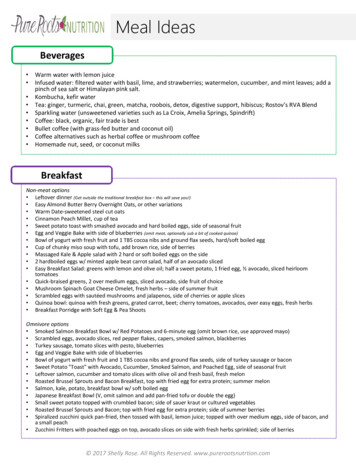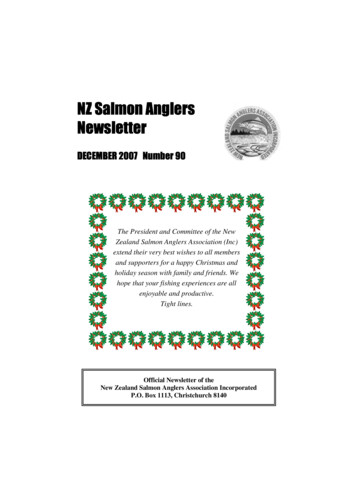
Transcription
NZ Salmon AnglersNewsletterDECEMBER 2007 Number 90The President and Committee of the NewZealand Salmon Anglers Association (Inc)extend their very best wishes to all membersand supporters for a happy Christmas andholiday season with family and friends. Wehope that your fishing experiences are allenjoyable and productive.Tight lines.Official Newsletter of theNew Zealand Salmon Anglers Association IncorporatedP.O. Box 1113, Christchurch 8140
NEW ZEALAND SALMON ANGLERS ASSOCIATION (INC)2007-08 OFFICE HOLDERS AND COMMITTEEPresidentRon Stuart358 9082021 216 3901cqurityron@xtra.co.nzImmediate PastPresidentNeville (Tim) Ellis383 0900021 363 140npellis@paradise.net.nzFax 383 0900Vice PresidentRon Dougherty338 2479Secretary &TreasurerPam Ellis383 0900021 211 3293npellis@paradise.net.nzFax 383 0900CommitteeJohn Healy03 318 82160274 334 511jhealy@xtra.co.nzFax 03 318 8190Phill Ball349 5993021 256 133Brian Foley352 8972Dennis Long352 2874Alf Long385 8651James Parbery03 312 8229Ken Paterson338 3115Athol Price332 7698Robert & Kristine McKey 338 4777PatronBruce Moody980 1065027 229 6302Douglas Roy352 8564021 173 6435Fax 352 3708krismick@xtra.co.nzdfroy@xtra.co.nzFax 352 8564Committee Meetings: The Committee meets on the first Monday each month (exceptJanuary) at 7.30 pm in the Fish & Game premises, 3 Horatio Street, Christchurch.Members and supporters are welcome to attend these meetings.Honorary Auditor: Trevor HayesLife Members:2Lindsay Dell, Ron Dougherty, Trevor Hayes, John Healy,Ken Hughey, Ross Lightfoot, Athol Price, Stephen Sparrow
PRESIDENT’SEDITORIALThe month has involved much planning,debate and discussion relating to our ovaplanting programme. The objective is tocontinue with the previous season’splanting sites where we had knownsuccess, to source new sites for 2008plantings, and contribute to ongoingpolicy debate with F&G. Also, tomonitor locations to ascertain if theprevious plantings increase the naturalspawning cycle, as it is now in the 3 yearexpected return period since theintroduction of Scotty Boxes.Other factors that influence the selectionof sites relate to approval requirements ofFish & Game: whilst they are permittedby the Department of Conservation tocarry out ova planting, they are requiredto co-ordinate the activities of ourAssociation and Rakaia River Promotionswith F&G Council policy and other usersor researchers involved with the sameriver locations. Therefore our ovaplanting proposal needs to be a knownfactor so that a structured outcome resultsand we do not affect other riverprogrammes. Another element is not toplant ova in the same locations currentlypopulated with spawning salmon. Yourcommittee has formulated a proposal thathas gone forward to F&G for approval.The season has kicked off well withreports coming in of some very healthysalmon being caught, including a 28lb fin-clipped salmon in the Rakaia and a 22pounder off the bank at MacIntosh’s.Given some of last season’s statistics wecould be trending upwards with returns,so get cracking with all those matters thatinfluence your ability to fish and startangling really soon.When and if you do have a “happylanding”, don’t forget to take a few scalesfrom the salmon and send them back toNZSAA for analysis. Scale envelopesare included with this newsletter andthere are plenty more available if youneed them.Also, have a look to see if the adipose finis missing, indicating that the salmon wasa Montrose hatchery fish. If it is, let usknow so that we can add this informationto our knowledge-base.And, enter your salmon in NZSAA’sannual competition. There are goodprizes to be won and all it takes is toweigh your fish (gutted and gilled withhead on), take a scale sample, fill in theentry form with a few details and send itback to NZSAA.I attended the Fish & Game AnnualGeneral Meeting on 5 December and apositive result was reported for the year.Fishing licences remain constant withapprox 12000 of us chasing salmon ortrout. The finances of the organisationwere in a healthy state and a broad rangeof activity undertaken. The influencingfactors using up a chunk of funds is theconstant battle with legal and resourcematters, so much part of our lives today,but if the path of equality or justice is notpursued we will miss out and suffer futureconsequences.3
At the meeting, a guest speaker fromDepartment of Conservation, HelenMcCaughan, gave a presentation on pestand illegal species of fish, which includeGambusia (mosquitofish), Koi Carp,Catfish and Rudd. The Departmentundertakes elimination programmes tocontrol or destroy these unwantedspecies, which is a somewhat dauntingtask. From your perspective, if you see afish in the water and it has orangecolouring it is probably a pest or anillegal species, so report yourobservations to DoC. If you catch one,kill it - do not release it back into thewater. The reason for exclusion of thesepests is their interference with naturalhabitat, pollution of waterways, foodchain competition and disease spread.Another plea I make to you is to reportany exceptional or unusual riverconditions to Environment Canterburyand Fish & Game, as we want all theinformation possible to support our casefor objections or recommendations. Thesefactors also include water being taken forirrigation when you consider the riverflow is below the minimum level, as thecurrent river recording methods are ofteninaccurate and users of water are unawarethey are breaching the provisions, plusECan need reminding to update theirmonitoring process.We have been considering options for theproduction of the newsletter from now on.One possibility may be to include oursalmon fishery articles in another fishingpublication which would give ourmembers a wider view of the fishingscene while still retaining the salmoninterests. However, if anyone out thereis willing and able to continue the presentnewsletter, then let’s hear from you soon.Have a great Fishing Season, enjoy eachmoment, and may the festive seasonprovide for all your good wishes.Ron StuartPRESIDENTQuote for the Month“Every day provides theopportunity for a PersonalBest – go out and do it”DisclaimerThe opinions expressed in any letters and articles in this newsletter are the authors’ own andare not necessarily those of the New Zealand Salmon Anglers Association (Inc) or the Editor.4
Montrose Hatchery InspectionsHow would you like to combine a fishing tripto the Rakaia with a brief visit to Montrose todo a quick check of the site?In addition to the weekly trips by volunteer teams to undertakecleaning of the Montrose races, there is a need for another generalinspection visit during the week. This includes a generalinspection of the site, to check the feeders, note dead fish, andmeasure the oxygen levels in the water. These weekly visits arenecessary through to July when the fish are due to be released.The Fish & Game volunteer vehicle is available for the purposeand a stopover to do a bit of fishing nearby in the Rakaia would beacceptable, providing you advise F&G of your planned trip andtimetable.The tasks are not onerous or time consuming and would takesome of the load off the one or two hardworking volunteers whogive a lot of time and travel each week to check on the Montrosehatchery. If you could assist, please phone one of the following:Doug Roy 352 8564Edgar Russ 980 1537Fish & Game (Steve Terry) 366 9191NZSAA: President Ron Stuart 358 90825
Introduction of Quinnat Salmon to New ZealandArticle by the late W (Bill) P Elsonpublished in The Press on 22 July 1972In his article on salmon in The Press on 1July, Mr C J Hardy claims that salmonwere established by the MarineDepartment over a 40 year period.However, he omitted to mention thatacclimatisation societies first introducedquinnat salmon into NZ in 1875, 26 yearsbefore the Government commenced thestocking policy in the Waitaki Riversystem.It is correct that the Government took upa stocking policy in the Waitaki system in1901 with ova supplied from California, agift from the United States FishCommission, but there were indicationsthat quinnat were already established, asearly as 1898, as the result of stocking byacclimatisation societies from 1875.In 1876 a large quantity of ova wasimported, 84,000 for the Government,60,000 for the Napier AcclimatisationSociety, and quantities for the Aucklandand Canterbury Acclimatisation Societies.The Government’s share was hatched inSouthland and of the resulting fry mostwere placed in the Five Rivers betweenEyre Creek and Lowther. The NorthIsland Societies placed fry in theWaikato, the Mahurangi and SouthernWairoa Rivers. The Wellington Societyreceived about 400 fry which werereleased in the Hutt River.TheCanterbury Society released 20,000 frydistributed in the Waimakariri, theRakaia, the Hurunui, the Rangitata, theAvon and the Ashley Rivers.6Releases in 1877In 1877 about 98,000 ova wereplanted, and around 1800 fry released inNorth Island rivers, by the Auckland andWellington societies. The Nelson Societyreceived 25,000 ova and resulting frywere released in the Motueka and WairoaRivers. Approximately 25,000 fry werereleased in the Grey River by the GreySociety. The Canterbury Society hatched30,000 fry, and 10,000 were released inthe Waimakariri River, 10,000 in theRangitata, with lesser numbers in theHurunui and Heathcote Rivers. About30,000 fry were hatched by the OtagoSociety and released in the Kakanui andWaipahi Rivers, whilst the SouthlandSociety released 35,000 fry in the OretiRiver, 18,000 in the Makarewa and10,000 in the Waipahi Rivers.In 1878 the Auckland society imported100,000 ova which were planted in theupper reaches of the Thames, whilst in1880 the Wellington society received5000 fry which were released in the HuttRiver.Eleven years passed, during which timeno further ova were imported, until theGovernment made a decision tocommence stocking in the upper reachesof the Waitaki and the Hakataramea. In1901, 500,000 ova were received fromCalifornia, given free by the United StatesFish Commission. Half was hatched atLake Ohau, the remainder atHakataramea, and in 1902 24,000 oneyear-old salmon were released in theWaitaki.
In 1903, 33,000 two-year-old fish werereleased in the Hakataramea River.During 1905, 385,000 fry were hatchedfrom ova which was supplied as a giftfrom the United States during 1904, andreleased in the Hakataramea. More than5000 three to four-year-old, and over10,000 one-year-old fish were releasedthe same year.A 16lb CatchIn 1906, 500,000 ova were received fromSan Francisco, resulting in 240,000 fryhatching at Lake Ohau, and over 220,000fry hatching at Hakataramea. These fishwere released, together with a quantity ofolder fish, and also 53,000 one-year-oldfish.The same year a 16lb salmon was takenfrom the Hakataramea, a tributary of theWaitaki. From 1907 to 1940 further ovawas obtained from the United Statesresulting in large releases of salmon.The Marine Department’s report in 1907made mention that quinnat had beentaken in the Hakataramea and that duringthe spawning season of 1907 establishedwild fish were being stripped, and in 1909235,000 ova were stripped, all from wildfish.In 1910, 25,000 ova were sent toTasmania and 150,000 sent to theGovernment hatchery on the West Coastof the South Island, and resulting frybeing released in the Hokitika system.The same occurred in 1913 when 250,000ova were stripped from the Waitaki, and150,000 having been hatched inWestland. The fry were released in theHokitika. A further 25,000 ova were sentto Tasmania the same year.Further imports of ova do not appear tohave been made but stripping of wild fishcontinued until 1940.The Marine Department’s report in 191516 mentioned that quinnat salmon hadbeen taken by anglers in the Waitaki,Rangitata and Rakaia Rivers. By 1921-22it was reported that quinnat wereoccurring as far north as the Waiau Riverto as far south as the Clutha River, and by1923 most Canterbury rivers were beingfished for salmon, good numbers of fishbeing taken from all of them.Unanswered QuestionThe question as to whether the quinnatsalmon was established in Canterburyrivers entirely from the stocking policyundertaken by the Government in theWaitaki system from 1901, or whetherthey were already established in the SouthIsland rivers at that time, is one that maynever be answered.There can be no disputing that goodresults were obtained from the Waitakistocking policy but there is also the strongpossibility that a wild stock wasestablished from the earlier liberations,before the Waitaki work was started.More than 50,000 fry had been releasedby the Canterbury AcclimatisationSociety by 1877 in several South Islandrivers (the Rakaia, Waimakariri,Rangitata and Hurunui) and whilst therecords show the first quinnat was takenin the Waitaki system, it must beunderstood that attention was beingfocused on this area because of the effortbeing made there at the time.The mode of transport then available,unlike today, restricted the anglers’ability to get out to the remote places,thus the chances of their reporting thepresence of quinnat, particularly in themore remote areas would be fairlyunlikely.(Continued on page 8)7
Very few people in New Zealand werecapable of identifying quinnat then andhundreds or even thousands could haverun up these rivers and spawned withoutbeing identified or even without theirpresence being known.Some of the stories told of huge troutbeing taken in these rivers in the earlyyears could be cases of mistaken identity.In a report in a sporting magazine, theauthor tells of seeing his dog chewing ona fish which had been lying dead, washedup on the shingle on the edge of theriverbed. The fish was 36 inches longand the year was 1898.It must be understood here that, unliketrout which normally spawn severaltimes, quinnat die near their spawninggrounds. Some drift downstream throughweakness until they are washed up alongthe edge of the river where they finallydie, and the carcasses decay there.The possibility of quinnat salmon beingestablished in New Zealand prior to 1900cannot therefore be dismissed.W P ElsonJuly 1972We Need Details ofFin-Clipped SalmonThe work at Montrose depends on knowing what fish are caught.If you do catch a salmon, have a look to see if the adipose fin ismissing which indicates it was of Montrose origin.Then please provide details (weight, length from nose to the forkof the tail, sex) to any of the contacts below:North Canterbury Fish & Game (03) 366 9191Central South Island Fish & Game (03) 615 4800Edgar (Rusty) Russ 980 1537Doug Roy 352 8564NZ Salmon Anglers Association 383 09008
reezersMURRAY SPIERS 26 Years ExperiencePersonal ServicePrompt AttentionGuaranteed WorkmanshipContact:Murray 027 221 3134383 2093 A/HHEALTH & SAFETY SYSTEMS LTDLEIGH TOBECKHealth and Safety ConsultantAND fishermanPhone 03 313 9114 or 0274 365 972www.healthandsafetysystems.co.nz9
Fish & Game NewsCommercial By-Catch of SalmonHurunui Water Conservation OrderDue to the low number of fishing vesselsoperating in the Salmon ConservationArea and minimal by-catch in the last fewyears, F&G have utilised volunteerobservers rather than a paid contractor.Eight volunteers offered their timefollowing articles in the NZSAAnewsletter and F&G fishing reports.Little progress has been made on thisapplication as the Ministry says that otherOrder applications already in process areof higher priority at present.Club RelationsAround 80-100,000 salmon fry aregrowing well at Montrose. NIIWA havedonated 3000 salmon smolt for theGroynes stocking programme. These aregrowing well at Montrose.Meeting held with NZ Salmon AnglersAssociation and Rakaia River Promotionsto plan next season’s ova plantingprogramme. Staff have provided copiesof old survey reports to the clubs to helpidentify waters where salmon once livedbut have since disappeared, as these arethought to be the most likely candidatesfor enhancement and restoration.Lake Coleridge SalmonDidymoStaff released a further 2000 120gram and3000 150gram smolt into the Ryton Bayat Lake Coleridge which had beengrowing at Montrose until water capacityforced the release.Fish & Game NZ have asked salmon andtrout anglers to be extra vigilant after thedidymo was confirmed in the RangitataDiversion Race. The Rangitata DiversionRace discharges water into theAshburton, Hinds and Rakaia Rivers.Salmon Enhancement ProgrammeCentral Plains Water/AshburtonCommunity TrustThe hearing is expected to commence on19 February 2008.Jason Hollandcontinues to work collaboratively withDOC to manage preparation of expertevidence.Waimakariri Flood Protection WorksF&G lodged a submission to a number ofconsents associated with proposedsecondary flood protection works adjacentto the Waimakariri River.Thesubmission sought, among other things,that the works did not result in reducedpublic access to and along the river.10F&G Environment Officer Jason Hollandsaid these rivers were previouslyconsidered free of didymo but, as a resultof RDR discharges, it is virtually assuredthat didymo will now infect these rivers.F&G has also expressed disappointmentat MAF’s ongoing willingness to grantpermits to irrigation companies totransport didymo. Currently, largeirrigation schemes discharge waterdirectly to other rivers. Additionally,some district council stock water schemestransfer water between waterways. MAFcould require irrigation companies toinvestigate and implement betteralternatives. For instance, F&G havesuggested that for smaller discharges,
discharging to ground via soakpits wouldbe an effective barrier to didymo spread.For larger discharges, we have suggestedthe irrigation company shouldcommission scientific studies todetermine what alternatives may beavailable. To date none of F&Gsuggestions have been adopted by MAF.Notwithstanding this concern, JasonHolland considers that the increasedlikelihood of didymo infecting rivers suchas the Rakaia is even more reason foranglers to check, clean and dry their gear.More on DidymoThe Rangitata Diversion Race dischargesinto the Rakaia River via the HighbankPower Station, which is in the middlereaches of the river. F&G’s main prioritynow is stop didymo moving upriver intothe critically important headwater salmonspawning streams. If didymo infects thosestreams, the sustainability of our sportsfisheries may be gravely endangered.“The Ministry of Agriculture andForestry (MAF) did not ignore yoursuggestion but took it seriously.However, discontinuing RDR dischargehad a high economic cost as it would stophydro power generation from theHighbank power station.MAF alsoconsidered that the RDR presented norisk of spreading didymo while the inleton the Rangitata was free of didymo. Themajor risk has always been fromrecreational river users moving didymoand infesting the waters at the RDR inlet.Essentially this is what has nowhappened.Fishing for trout or salmon has alreadybeen banned in many Rakaia andRangitata spawning streams to minimisethe risk of didymo spread. Waters thathave been closed to fishing are signpostedand are also listed in regulation bookletsissued when purchasing sportsfishinglicences. For the Rakaia these includeDouble Hill Stream, Glenariffe Stream,Hydra Waters, Manuka Point Stream andWinding Creek and Deep Stream andDeep Creek in the Rangitata. Fishing inthe Highbank tailrace itself is also closedto sportsfishing.F&G asks all anglers to be extremelyvigilant about checking, cleaning anddrying their gear when fishing theRakaia, Ashburton or Hinds Rivers.This includes following the sameprocedure if moving considerabledistances up the same river during afishing expedition.Rakaia River & the RDRAs reported in our November newsletter,NZSAA wrote twice to Biosecurity NZrequesting that the discharge of RDRwater into the Rakaia River be stoppedbecause of the risk of didymo infection.As we predicted, didymo is now in theRakaia River.Part of the reply from Biosecurity NZ isas follows:“Prior to the infestation of didymo in theupper Rangitata River, the most logicalapproach to preventing didymo wouldhave been to close all rivers in the area toall recreational river users.Thisapproach was considered by MAF butwas rejected because the logistics ofpolicing such a closure would have beenimpossible to resource.“You also stated your belief thatBiosecurity NZ and other consentingauthorities have a legal responsibilityunder the Rakaia River National WaterConservation Order 1988 to stop thedischarge of terminal RDR water to theRakaia River.11
MAF has examined the ConservationOrder and considers that it does not havea responsibility under the Order to stopthe discharge of the RDR to the RakaiaRiver.”NZSAA invites its members to form theirown opinion on this reply fromBiosecurity.However we make thefollowing points: As pointed out by Fish & Game, itseems to be OK for the largeirrigation companies to spreaddidymo and place the blame on therecreational users of the rivers. Hydro generation from Highbankoccurs mainly in the winter whenirrigation requirements are small, sothe “high economic cost” isquestionable.What is the economic cost to NZrecreational tourism if the sportsfishery is destroyed?Apart from briefformalacknowledgements, no response hasbeen received to our two letters to theMinister for Biosecurity, Hon JimAnderton. He did however becomeswiftly involved when the NorthIsland trout fishery suffered a didymoscare. Niwa's dead didymo gaffeFrom an article by WARWICK RASMUSSEN Waikato Times, 24 November 2007.The Government agency responsible forkeeping the country's waterways cleanwas confirmed as the source of dead cellsof the invasive algae didymo it said wasfound in North Island waterways lastmonth. It was revealed by BiosecurityMinister Jim Anderton that the cells weretaken from a Christchurch NIWAlaboratory to the North Island in vial lids.NIWA chief executive John Morgan says12he is baffled as to how they got on thelids in the first place.Last month's "discovery" of the dead cellsafter samples were taken in the NorthIsland sent shockwaves through thefishing sector. NIWA announced theinvasive algae, also known as "rock snot",had been found in four waterways theTongariro, Whakapapa, Mangatepopo andWhanganui Rivers. Mr Anderton said thejoint ministry and NIWA investigationtraced the contamination back toChristchurch. "The investigations foundthat pottle lids sent to Turangi werecontaminated with microscopic amountsof dead didymo cells," Mr Anderton said.The vials and lids were sent north forNIWA to conduct water testing on behalfof Genesis Energy. Mr Morgan said staffdirectly involved were extremelyfrustrated at what had happened, but hestopped short of calling it anembarrassment for the organisation,which is responsible for protecting thesustainability of the nations's waterways.Mr Morgan said a full review of handlingprocedures was already under way.Taupo Trout Guides' Brendon Mathewssaid his first reaction to Mr Anderton'sannouncement was "relief", but he stillhad little confidence in the Government'sability to keep didymo out of the NorthIsland. "There's been a lot of uncertaintydown here over the past few weeks. This(didymo) is a ticking time bomb thatwon't go away." He said Biosecurity NewZealand wasn't doing enough to stop thealgae from making its way north. At themoment didymo is only in South Islandwaterways. If it did make it into the southof the Waikato-Taupo region, didymocould jeopardise the area's 250 milliontrout fishing industry.
Another ViewNZSAA member David O’Neill has hisown view on the didymo problem:“On the didymo thing I have been doing abit of a trawl of the various sites wherethe infections are and visited a few. Theone thing that impresses me most is thesimilarities of all the spots that I havebeen to.Caravan for Sale16ft Clansman 4 Berth 16,000 o.n.oRepainted last year.On site at KairakiMotor CampClear water, well oxygenated, goodsunlight. However it hit me on the Gowanthat where there was good cover of treesor scrub with consequent shading theinfections seemed less bad. Or am Iimagining it?Extras:Take the Ahuriri. Recently DOC cut outall the willows and the rock snot has gotworse. More light more snot seems to bethe cue. This can have importantimplications for fishery protection andlimitation of growth of the algae. I have fished most of Scotland andNorthern England where unless I ammistaken didymo is actually endemic. Inthe main the light is poorer and the wateris less clear. Also the winters are longerand more drab and thus the snot has nottaken over waterways like it has here.Good argument for riparian plantingsespecially in spawning tribs where wholeshading can be achieved. Dunno whatyou guys think but I have half convincedmyself.”David O’Neill7 December 2007 Wooden awning floorTwo bunk bedsFreezerTwo electric heatersTV , radio and aerialHooded BBQ, gas bottleand toolsCooker with ovenSandwich makerBench-top cookerMicrowave cookerTable lampsSmall chest of drawersBlankets and pillowsCrockery and saucepansAll cutleryGarden chairsAwning, carpet and vinylPorta PottyTelephone (03) 353 8564or 021 173 643513
Sockeye Salmon: the Best Run for 25 years.by Graeme Hughes, Fish and Game Officer Central South Island RegionEarly in 2007 it was reported thatSockeye Salmon had been seen andcaught in the Haldon Arm of LakeBenmore. By late February thousands ofSockeye Salmon weremigrating intothe lower Ohau River to spawn.Sockeye Salmon, Onchorhynchus nerka,were released into the tributaries of LakeOhau in 1901. In early fisheries literaturethis species was thought to be Kokaneethe lake dwelling form of Sockeyesalmon. More recent studies of the NewZealand “Sockeye” indicate that the ovacollected was from anadromous (seagoing) Sockeye salmon,not lakedwelling Kokanee and that the resultantprogeny failed to produce a sea goingpopulation. In their country of origin thenonanadromous progeny of anadromousSockeye salmon are called “residuals”.Sockeye salmon are plankton feeders andare seldom caught by anglers and it wasthought that the species had failed toestablish until in the 1960’s they wereobserved spawning in the newlyconstructed Aviemore spawning race. Onfurther inspection this little knownspecies was found spawning in severaltributaries of the Waitaki Valley lakesfrom Lake Aviemore to Lake Ohau.Larch Stream, a small spring fed streamat the head of Lake Ohau proved to be themost used spawning stream for“sockeye”. In the late 1970’s 16,000 werecounted in Larch Stream. Research onSockeye Salmon showed that there weretwo distinct populations, a Lake Ohaupopulation and a Lake Benmorepopulation. The Benmore Sockeye werelarger and more coloured than the Ohausalmon. Many of the spawning salmon14develop orange to red flanks, males areoften more brightly coloured with adistinctive hooked snout. They areaggressive fighters once in the spawningstream and especially during the egglaying period. At this time some of thepopulation will strike at a small spinneror feathered lure.The resurgence of this little knownspecies has surprised fisheries staff andanglers. The Sockeye salmon was thoughtto be almost extinct since its mainmigration route, the lower Ohau Riverwas dewatered with the construction ofthe hydro canal which diverts the water toOhau “B” and “C” hydro electric powerstations. In 1982 thousands of salmonarrived at the Ruataniwha Spillway tofind their upstream migration routepermanently blocked. A huge relocationoperation began and 8000 sockeyesalmon were captured and transported tomany streams within 50 km of thespillway. It appears that the relocationattempts were not successful as noreturning salmon have been seen in any ofthe release sites.Today where 70 cumecs once flowed,springs and seeps provide a small residualflow in the lower Ohau River, and it isthis flow which has attracted the SockeyeSalmon. Recently Fish and Game andEnvironment Canterbury engineeringstaff embarked on a major clearing of asmall spring fed tributary of the LowerOhau which historically had been a wellused spawning stream for salmon andtrout. Sockeye salmon have moved intothe enhanced stream and are spawningover its entire length wherever suitablegravels exist.
In March 2006, 752 salmon were countedin the lower Ohau River and 104 in theenhanced tributary.Prior to their spawning run maturingsockeye salmon have been caught byanglers trolling for brown and rainbowtrout in Lake Benmore around the rivermouths or where tailrace of Ohau “C”flows into the lake. Although Sockeyesalmon feature only occasionally in theanglers bag their presence in WaitakiValley lakes is of great value to thefishery in that the juveniles, which dropback to the lakes after hatching, providethe trout fishery witha large andimportant food source. Large trophy troutin Lake Ohau disappeared soon after thedemise of the migratory sockeye salmonrun from Lake Benmore.An aerial count of the rivers and streamswhich flow into the Haldon Arm of LakeBenmore was completed on the 19thMarch. In the lower Ohau River 7,400salmon were counted, 1600 in the TekapoRiver, 570 in the lower Twizel River, 300in the enhanced tributary, 96 in GreysRiver and 14 in the outflow of theMaryburn Ponds.No salmon wereobserved in the Lake Ohau tributaries.Within the region there are tworecognised populations of Sockeyesalmon, one in Lake Benmore the other inLake Ohau. Sockeye salmon have beencaught in Lake Ruataniwha howeverthese are probably remnants of the LakeOhau population.It is not clear why there has been aresurgence in the Sockeye salmonpopulations however it is certainly goodnews for the fishery and indirectly theangler.The upper Waitaki SockeyeSalmon population is the only populationin New Zealand and the only populationin the southern hemisphere.Graeme HughesSALMON ANGLERSCAPSPromote your AssociationBuy a CapThe caps are navy blue, with asilver/grey salmon, orange printand white and gold stripes.Cost 20.Each cap you purchase includes asmall donation to the SalmonReco
monitor locations to ascertain if the previous plantings increase the natural spawning cycle, as it is now in the 3 year expected return period since the introduction of Scotty Boxes. Other factors that influence the selection
